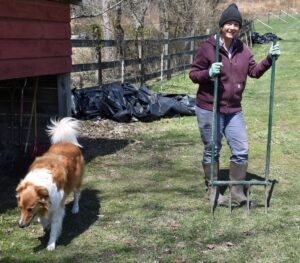Hello fellow readers, I adore learning from Patti Doell of Little Big Farm, a cut flower farm in Blairstown, NJ. We spoke in late winter when her seed-starting was underway, and I found out she adopted the no-till gardening technique. Also known as no-dig gardening, it’s the practice of not disturbing the soil by turning it over.
Soil is in a living thing.
Soil has microorganisms, nematodes, fungi, protozoa, and earthworms, which work together to decompose organic matter that nourishes the soil and adds aeration, improving drainage and moisture retention. As a result, not only will plants grow better and produce more, but they’ll also be more resistant to pests, diseases and are more tolerant of periods of drought.
Patti invited me to visit the farm a few weeks ago to see the no-till system firsthand.
“The soil didn’t look like this three years ago because I was constantly tilling, bringing the clay soil and weed seeds to the top.” Her soil is now dark, rich, and fluffy and with far fewer weeds.
Using a broadfork rather than a rototiller.
Instead of tilling, she uses a broadfork. Patti demonstrated the tool, which looks much like a wide spade fork but with a flat crossbar. “There’s no need for a gym,” I said while watching her.

Patti Doell, owner of Little Big Farm (and Buttercup), demonstrating a broadfork used in no-till gardening.
Patti puts both feet on the crossbar with the fork straight on the soil and uses her weight to push the tines into the ground, then rocks to loosen it. Keeping her feet on the crossbar, she pulls back, taking advantage of the tools leverage and her bodyweight to add air to the soil. She stands behind the area she’s forking not to compact the earth as she’s working.
“While it may seem more labor-intensive,” she said, “I would have to go through with a tiller three to five times to get the soil broken up enough. Then I’m just killing the soil and all the organisms that live in there.”
The Cliff-notes version of No-till Gardening…
Briefly, the no-till system is “cover crop, tarp, fork, and I’ll put an inch of compost on top which acts as a mulch. Then I can seed right into it.”
Planting cover crops between seasons or between crops help increase soil fertility, reduce erosion versus exposed soil, and suppress weeds. For example, Patti used mustard in the fall, which dies down in the winter. She tarps it, then come spring forks it, adds an inch of compost, and then plants.
Others cover crops she uses include peas, ryegrass, and oilseed radish. Patti suggests cover crops for home gardeners as well. And adding an inch of compost on top in the fall before the cover crop and again in the spring keeps weeds down and adds more nutrients to the soil.
Happy soil = Happy plants.
Dying roots also help build soil. Patti explained how they used to pull out the sunflowers in the fall, knock the dirt off and compost them. Now she cuts down the stalks and leaves the roots. The few that Patti pulled up in the spring in the way of forking had many worms and tiny insects, plus the critters we can’t see with the naked eye. “Which is exactly why you want to leave dying roots in the soil. Plus, it’s far less work.”
“The first time using a broadfork is more difficult because you’re getting down to the deeper level of soil for the first time, but after that, it gets easier. By the third or fourth time, it sinks right in. I hardly need to fork it at all anymore.”
I asked what inspired Patti to start this system?
“The tiller was always broken. Every spring, your equipment fails right when you need it. If you’re a farmer, that’s just the way it is,” she laughs.
Another dilemma is soil must be dry to till; otherwise, you’ll make concrete. “By using a broadfork, you can get into the garden earlier.”
An early start, better soil, healthier plants, and less work, indeed, no-till gardening is more than a win-win. Garden Dilemmas? AskMaryStone@gmail.com (and your favorite Podcast App.)
Click through for more on the subject- Starting a No-till Garden
This story is featured in Episode 28 of the Garden Dilemmas Podcast on wherever you get your podcasts or the link below:
You’ll enjoy more insights shared by Patti Doell in Green with Envy Seed Starting Tips.



